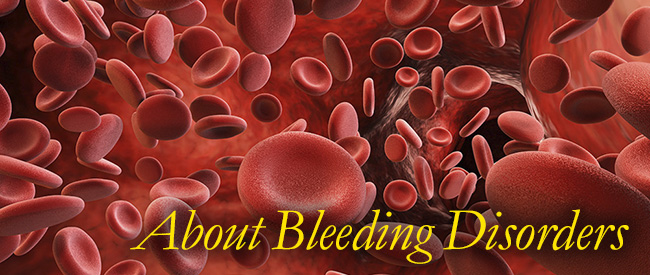Page Contents

Bleeding Disorders Resources
About Bleeding Disorders
When you or a family member are first diagnosed with a bleeding disorder, it can be overwhelming — emotionally and financially.
 You are not alone and there are great resources for those
just like you. The Rocky Mountain
Hemophilia & Bleeding Disorder Association (RMHBDA) is here to help you by answering questions, providing resources, and introducing you to others who are experiencing the same concerns.
You are not alone and there are great resources for those
just like you. The Rocky Mountain
Hemophilia & Bleeding Disorder Association (RMHBDA) is here to help you by answering questions, providing resources, and introducing you to others who are experiencing the same concerns.
We provide opportunities to learn from others and from experts. We can partner you with another family who has been through what you are now experiencing. It can be very helpful and comforting to talk with someone who has had the same experience and has learned to manage their bleeding disorder.
Learning to live with a bleeding disorder
Shock and disbelief often accompany learning you or a loved one has a bleeding disorder. It is perfectly normal to experience many upsetting emotions and have a feeling of fear and loss of control. Gaining information and experience will lessen the fear over time and grant you more control over the situation. The more you learn, the more you can incorporate VWD into the routine of your daily life.
Help & support is available:
- Connect with your nearest Hemophilia Treatment Center for comprehensive medical services.
- For a complete list of Hemophilia Treatment Centers, visit National Blood Disorders Foundation.
- Join your local Bleeding Disorders Chapter. For a complete list of local chapters, visit National Blood Disorder Foundation.
Hemophilia & von Willebrand Disease
Hemophilia
Hemophilia is caused by a deficiency or defect in the protein necessary for blood to clot properly. These proteins are known as 'clotting factors.' The type and severity of a person’s hemophilia depends on which protein is involved and to what degree he or she is deficient. The most common forms of this disorder are:
- Hemophilia A, which is a deficiency of Factor VIII
- Hemophilia B (also called Christmas Disease), which is a deficiency of Factor IX
Bleeding into joints and muscles over time can lead to chronic pain, arthritis, deformity, and disability. In addition, bleeding occasionally occurs in the brain and other vital organs that can be life threatening. Hemophilia affects mostly males and occurs in one out of 7,500 male births.
Hemophilia symptoms include:
- Easy bruising
- Bleeding into joints and muscles
- Spontaneous bleeding
- Prolonged bleeding
Note that the costs of treating severe hemophilia are high, sometimes $100,000–$200,000 per year or more.
What is von Willebrand Disease?
Although less widely known, von Willebrand Disease (VWD) is understood to be the most common inherited bleeding disorder, affecting millions of people worldwide. The prevalence is as high as 1 to 2% in the general population.
VWD is a bleeding disorder caused by missing, non-functioning, or decreased amounts of a factor called von Willebrand Factor (VWF). Although usually inherited, VWD can also be the result of a spontaneous, new genetic mutation. The abnormal gene in VWD is located on a chromosome called an autosomal chromosome or autosome, rather than a sex-linked chromosome (like hemophilia is carried on). Therefore, the inheritance of VWD can occur equally among females and males.
There are three sub-categories of VWD
- Type I
Accounts for 60–80% of cases, results from a decreased production of normal VWF and factor VIII — decreased amounts of VWF and factor VIII. - Type II
Accounts for 10–30% of cases, is characterized by qualitative abnormalities of VWF and is further divided into subtypes 2A, 2B, 2M, and 2N- non-functioning VWF. - Type III
Accounts for 1–5% of cases, is the most severe form of the disease and is characterized by a very low or undetectable VWF in plasma and a low factor VIII activity. 1 in a million people have type III VWD. Symptoms are more frequent and severe — missing or very low levels of VWF and factor VIII.
What are the symptoms & effects of von Willebrand Disease?
Some individuals with VWD do not show any symptoms of the disease while others show mild to severe symptoms. Typical signs include:
- Prolonged nosebleeds
- Easy bruising
- Heavy menstrual flow
- Excessive or unusual bleeding from the gums and mouth
- Pro-longed bleeding associated with surgery
- What does von Willebrand Factor do in the blood?
Blood does a lot of different things as it circulates through the veins. The blood is made up of four main components: plasma, which contains blood clotting proteins; red blood cells, which carry oxygen; white blood cells, which defend the body from infection; and platelets, round, sticky cells that help plug or seal off tears in blood vessels. One of the most important substances that makes the platelets stick together is VWF. This substance is essential for platelet-plug formation. VWF works as a “platelet glue” and also helps protect factor VIII and transport it through the body. Individuals with VWD are missing, have non-functioning, or decreased amounts of VWF, so they are either unable to form a platelet-plug or it is a pro-longed process.
How is a person diagnosed with von Willebrand Disease?
Bleeding symptoms, family history, test results, and routine blood tests prior to surgery are where diagnosis starts. However, VWD can be hard to diagnose because symptoms can be different in every patient, even those in the same family. Testing can also be complicated. Many kinds of blood tests are needed, so it is important to contact a hematologist at a Hemophilia Treatment Center (HTC) for proper diagnosis.
What treatment options are available?
Treatment is based on the type of VWD and the symptoms. In order to correct clotting problems, VWF and factor VIII levels need to be raised. Here are some common treatments:
- DDAVP
Synthetic copy of a natural hormone that releases the body's stored VWF into the bloodstream and increases levels of factor VIII, usually taken by infusion or nasal spray, and most effective for type I patients. - Replacement therapy
These medicines contain actual VWF proteins and factor VIII concentrates, taken by infusion, and effective for VWD patients who do not respond to DDAVP and for patients with type 2B and type III VWD. - Local clotting agents (antifibrinolytics)
They can be used to help the body protect clots and hold them in place, taken as injection or oral (tablet, capsule, elixer, or mouthwash). - Oral contraceptives
Birth control pills can increase VWF levels and can be useful for women with heavy menstrual bleeding.
Viral Complications
In the past, blood clotting concentrates were not screened for viruses, including HIV and Hepatitis. As a result, many individuals with bleeding disorders contracted the viruses through contaminated blood products. In fact, prior to 1985 many hemophiliacs became infected with HIV, the virus that causes AIDS (Acquired Immune Deficiency Syndrome), through these contaminated blood products.
However, in the past 15 years, many changes have taken place with regard to product safety. Now, commercially prepared blood clotting concentrates have been screened for the presence of viruses such as HIV and Hepatitis. Different heating and pasteurization methods are now used by manufacturing companies who make blood clotting concentrates. These methods make the products free of the viruses for which they are screened.
To learn about the specific screening process of your product manufacturer, please contact them directly.
Contact Info
1627 West Main Street, #142
Bozeman, Montana 59715
406.586.4050
Sponsors




